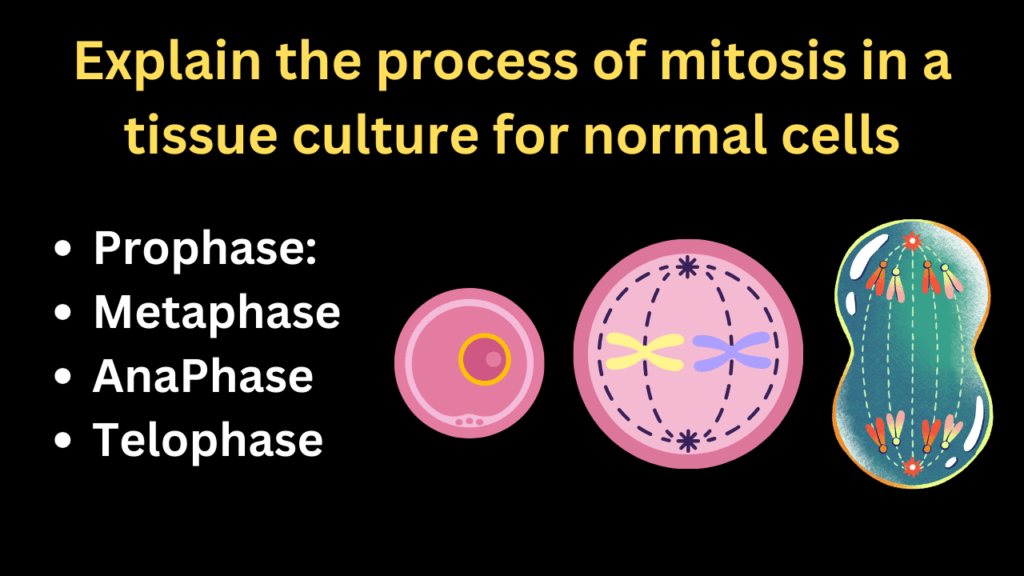Mitosis is a fundamental process in cell division, and it plays a crucial role in tissue culture for the growth and propagation of normal cells. Tissue culture involves the in vitro (in a laboratory setting) cultivation of cells and tissues under controlled conditions.

Here’s the process of mitosis in tissue culture for normal cells.
- Cell Selection and Preparation: The first step in tissue culture is to obtain a sample of normal cells from a living organism. These cells are typically selected based on the type of tissue or organ of interest. The cells are carefully collected, usually through techniques like biopsy or enzymatic dissociation, to ensure their viability.
- Establishment of a Cell Line: Once the cells are collected, they are cultured in a suitable growth medium. This medium contains essential nutrients, salts, vitamins, and growth factors necessary for cell survival and proliferation. Fetal bovine serum (FBS) is often used to provide growth factors and hormones that support cell growth.
- Attachment and Growth: The collected cells are then seeded into culture dishes or flasks, where they adhere to the surface. Attachment is a critical step, as it allows the cells to receive nutrients and signals from the culture medium. Cells are typically maintained in a controlled environment with regulated temperature, humidity, and carbon dioxide (CO2) levels.
- Interphase: Interphase is the phase of the cell cycle when the cell prepares for mitosis. During interphase, the cell undergoes three subphases: G1 (gap 1), S (synthesis), and G2 (gap 2). In G1, the cell grows, synthesizes proteins, and prepares for DNA replication. In S phase, DNA replication occurs, ensuring that each chromosome duplicates. G2 is a period of additional growth and preparation.
- Mitosis: Mitosis is the process of nuclear division that results in two genetically identical daughter nuclei. It consists of several stages:
- Prophase: During prophase, chromatin condenses into visible chromosomes, and the nuclear envelope begins to break down. The spindle apparatus, consisting of microtubules, starts to form.
- Metaphase: Chromosomes align at the cell’s equatorial plane, known as the metaphase plate. This alignment ensures that each daughter cell will receive an identical set of chromosomes.
- Anaphase: Sister chromatids (duplicated chromosomes) are separated and pulled towards opposite poles of the cell by spindle fibers.
- Telophase: In telophase, the separated chromatids reach the opposite poles and decondense back into chromatin. New nuclear envelopes form around each set of chromosomes, creating two distinct nuclei.
- Cytokinesis: While mitosis is specifically the division of the nucleus, cytokinesis follows, which is the division of the entire cell. In animal cells, a contractile ring of actin filaments pinches the cell membrane, leading to the formation of two daughter cells, each with its nucleus.
- Growth and Expansion: After mitosis and cytokinesis, the two daughter cells continue to grow and expand in the culture medium. They replicate their organelles and cellular structures to prepare for the next round of cell division.
- Repeat and Passage: As cells continue to grow and divide, they can become confluent, meaning they cover the entire surface of the culture vessel. To prevent overcrowding and maintain cell health, cells are periodically “passaged.” This involves detaching the cells, typically using enzymes or mechanical dissociation, and transferring them to new culture vessels with fresh growth medium. This process allows for the continuous expansion of the cell population.
- Maintenance: The culture is maintained under controlled conditions, and the cells are regularly monitored for signs of contamination, changes in growth characteristics, or other anomalies. Additionally, the culture medium is replenished periodically to ensure optimal nutrient levels.
NOTE: The process of mitosis in tissue culture allows for the controlled expansion of normal cells outside of the living organism. This is invaluable in various fields, including cell biology, drug development, and regenerative medicine, as it provides a consistent and controlled source of normal cells for research and therapeutic purposes.